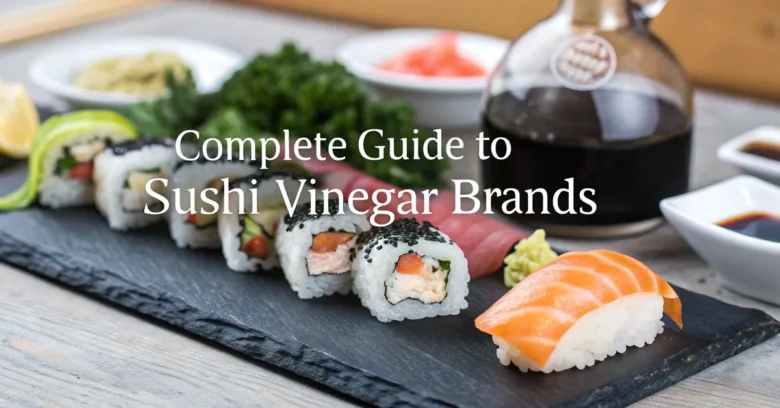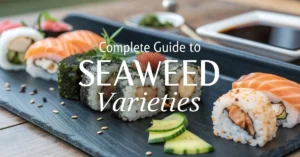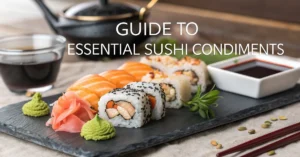Choosing the right rice vinegar can be a tricky affair. You might think all bottles labeled “rice vinegar” are created equal. But, just like how there is a world of difference between a cheap grocery store wine and a carefully aged vintage, the same holds true for rice vinegar.
Navigating the options can feel overwhelming, especially when you are at home trying to replicate the taste of restaurant-quality sushi. The good news is that with a little knowledge, you can confidently select the perfect rice vinegar to elevate your homemade sushi to a whole new level.
This guide is designed to be your go-to resource, breaking down everything you need to know about rice vinegar brands. From understanding the nuances of flavor profiles to identifying the best uses for each type, we will equip you with the knowledge to choose the right one for your needs.
Complete Guide to Sushi Vinegar Brands
What is Rice Vinegar?
At its core, rice vinegar is an acidic liquid made from fermented rice. The process begins with cooking rice and then introducing a culture to convert the starches into sugars. These sugars are then fermented into alcohol, which in turn is converted into acetic acid, the key component of vinegar.
But that’s where the simplicity ends. The type of rice used, the fermentation process, and whether or not additional ingredients are added all influence the final flavor profile. This is why some rice vinegars have a mild and delicate sweetness, while others possess a more pronounced tang.
Rice vinegar is not just an ingredient for sushi. It’s a versatile staple in Asian cuisine, finding its way into dressings, marinades, and sauces. It’s valued for its ability to add a gentle acidity that balances flavors without overpowering other ingredients.
Why is Rice Vinegar Important for Sushi?
Rice vinegar is more than just an ingredient in sushi rice; it’s the backbone of its distinctive flavor and texture. Here’s why it’s so essential:
- Flavor: Rice vinegar adds a subtle tang and sweetness that complements the delicate flavors of the fish and other ingredients. It is that signature taste that elevates sushi from simple ingredients to a culinary experience.
- Texture: The acidity of the vinegar helps to firm up the cooked rice, preventing it from becoming mushy. This ensures that each grain remains distinct while still clinging together, creating the perfect texture.
- Preservation: Vinegar has natural preservative properties, which help to extend the shelf life of the sushi rice. In a cuisine that emphasizes freshness, this is a crucial benefit.
In essence, rice vinegar is not simply an add-on; it’s an integral component that defines the very essence of sushi.
Types of Rice Vinegar
When you walk down the Asian foods aisle of your local grocery store, you will notice several types of rice vinegars. Knowing the differences between each type will help you select the best one for your sushi:
White Rice Vinegar
This is the most common type of rice vinegar and is often the default choice for sushi rice. It has a clean, slightly sweet, and mild flavor profile. Its light acidity doesn’t overpower the other ingredients, making it ideal for sushi.
Brown Rice Vinegar
Made from brown rice, this vinegar has a nuttier and more complex flavor compared to its white rice counterpart. It is a good choice if you want to add a subtle depth to your sushi rice. The flavor is not very prominent, so it will not impact the taste of the other ingredients.
Seasoned Rice Vinegar
This is rice vinegar with added sugar and salt. It is designed to simplify the sushi-making process. While convenient, seasoned rice vinegar offers less control over the final flavor. This means you can’t adjust the tang or sweetness as needed.
Black Rice Vinegar
Common in Chinese cuisine, black rice vinegar is richer, smokier, and less sweet than other types. It is generally not used in sushi but is excellent in dipping sauces or marinades for cooked dishes that you can serve with your sushi meal.
Red Rice Vinegar
This vinegar has a vibrant color and a tangy, slightly sweet flavor. Like black vinegar, it’s more commonly used in Chinese dishes, such as stir-fries or sweet and sour sauces. While it is not traditional for sushi rice, you can experiment with a small amount in sauces or as a marinade.
Factors to Consider When Choosing Rice Vinegar
To find the perfect rice vinegar, consider the following factors to ensure it aligns with your taste preferences and the specific requirements of your sushi:
Flavor Profile
- Sweetness: How much sweetness do you prefer in your sushi rice? Some vinegars have a more pronounced sweetness, while others are tangier.
- Acidity: A higher acidity will give your rice a more noticeable tang. If you prefer a milder flavor, opt for a vinegar with lower acidity.
- Complexity: Brown rice vinegar offers a nuttier, more complex flavor, while white rice vinegar is cleaner and more straightforward.
Ingredients
- Pure Rice Vinegar: For maximum control over the flavor, choose pure rice vinegar with no added ingredients. This allows you to adjust the sweetness and saltiness to your liking.
- Additives: Be wary of vinegars with artificial flavors, preservatives, or excessive amounts of sugar. These additives can detract from the natural flavor of the sushi.
Intended Use
- Sushi Rice: White rice vinegar is generally the best choice for sushi rice due to its balanced flavor.
- Dipping Sauces: Experiment with black or red rice vinegar for dipping sauces to add a unique twist.
- Marinades: Rice vinegar can be used in marinades to tenderize and flavor fish or vegetables.
Brand Reputation
- Read Reviews: Look for brands with consistently positive reviews regarding flavor and quality.
- Check Origin: Some regions are known for producing higher-quality rice vinegar. For example, Japanese rice vinegar is often considered superior due to strict production standards.
Top Rice Vinegar Brands for Sushi
Now that you know what to look for, here are some of the best rice vinegar brands to consider for your sushi:
Marukan
- Origin: Japan
- Type: White Rice Vinegar, Seasoned Rice Vinegar
- Flavor Profile: Marukan is renowned for its mild, slightly sweet flavor. The white rice vinegar is a versatile choice for sushi rice, while the seasoned version offers convenience with a consistent flavor.
- Why it’s great: Marukan rice vinegar is expertly crafted to provide a delicate yet distinct taste that complements the natural flavors of sushi. The brand has a rich history of vinegar production.
Mizkan
- Origin: Japan
- Type: White Rice Vinegar, Seasoned Rice Vinegar
- Flavor Profile: Mizkan offers both white and seasoned rice vinegar. The white rice vinegar has a clean, balanced flavor, while the seasoned version is a convenient option for sushi rice.
- Why it’s great: Mizkan is a household name in Japan and is known for its consistent quality and balanced flavor profiles. Both the white and seasoned rice vinegars are excellent choices for making authentic sushi rice.
Kikkoman
- Origin: Japan
- Type: Rice Vinegar
- Flavor Profile: Kikkoman Rice Vinegar has a mild and slightly sweet flavor profile with a clean and crisp taste. Its balanced acidity enhances the taste of sushi without overpowering the delicate flavors of fish and other ingredients.
- Why it’s great: Known for its soy sauce, Kikkoman also produces high-quality rice vinegar. This rice vinegar is meticulously crafted to ensure a delicate balance of flavors, making it an excellent choice for sushi enthusiasts.
Eden Foods
- Origin: USA (using Japanese methods)
- Type: Brown Rice Vinegar
- Flavor Profile: Eden Foods Brown Rice Vinegar has a rich, nutty, and subtly sweet flavor. The taste is derived from organic brown rice, which is carefully fermented to create a deep, complex profile.
- Why it’s great: Eden Foods Brown Rice Vinegar is a versatile choice for those looking to add depth and character to their sushi. The vinegar’s robust flavor pairs well with a variety of ingredients, making it a sophisticated addition to your sushi-making endeavors.
Nakano
- Origin: USA
- Type: Seasoned Rice Vinegar
- Flavor Profile: Nakano Seasoned Rice Vinegar features a harmonious blend of sweet and tangy flavors, crafted with precision for culinary perfection. Made with high-quality rice and carefully balanced seasonings, it adds a distinct yet subtle zest to your dishes.
- Why it’s great: It is ready-to-use and adds a balanced flavor to sushi rice, saving time and effort in the kitchen.
Kadoya
- Origin: Japan
- Type: Rice Vinegar
- Flavor Profile: Kadoya Rice Vinegar has a light and refreshing flavor with a gentle sweetness and subtle tartness. This vinegar enhances the flavors of sushi without overwhelming the taste of the fish and other ingredients.
- Why it’s great: It is highly valued for its exceptional quality and ability to enhance the flavors of sushi. Known for its commitment to traditional brewing methods, Kadoya ensures its rice vinegar is pure and untainted, providing an authentic taste of Japan.
How to Make Sushi Rice with Rice Vinegar
Making perfect sushi rice is an art, but with the right technique and ingredients, you can achieve restaurant-quality results at home. Here’s a step-by-step guide:
Ingredients
- 2 cups Japanese short-grain rice
- 2 cups water
- 1/4 cup rice vinegar
- 2 tablespoons sugar
- 1 teaspoon salt
Instructions
- Rinse the Rice: Place the rice in a bowl and cover it with cold water. Gently swirl the rice with your hand, then drain the cloudy water. Repeat this process until the water runs clear. This removes excess starch, preventing the rice from becoming sticky.
- Cook the Rice: Combine the rinsed rice and 2 cups of water in a pot. Bring to a boil, then reduce the heat to low, cover, and simmer for 18-20 minutes, or until all the water is absorbed. Remove from heat and let it steam, covered, for another 10 minutes. This ensures that the rice is cooked evenly and has the right texture.
- Prepare the Vinegar Mixture: In a small saucepan, combine the rice vinegar, sugar, and salt. Heat over low heat, stirring until the sugar and salt are completely dissolved. Do not boil. Remove from heat and let cool slightly.
- Combine Rice and Vinegar: Transfer the cooked rice to a large wooden bowl (hangiri). This type of bowl helps to absorb excess moisture. Gently fluff the rice with a rice paddle or spatula. Gradually drizzle the vinegar mixture over the rice, mixing gently to ensure even distribution. Be careful not to mash the rice.
- Cool and Fan: While mixing, use a fan to cool the rice quickly. This helps to create a glossy sheen and the desired texture. Continue fanning and mixing until the rice is cooled to room temperature.
- Keep Moist: Cover the sushi rice with a damp cloth to prevent it from drying out until you are ready to use it.
Tips for Perfect Sushi Rice
- Use Short-Grain Rice: Japanese short-grain rice is essential for sushi. It has a higher starch content, which gives it the necessary stickiness.
- Adjust Sweetness and Tang: Taste the rice and adjust the vinegar mixture to your liking. Some people prefer a sweeter rice, while others prefer a tangier flavor.
- Don’t Overmix: Be gentle when mixing the rice and vinegar to avoid breaking the grains.
- Use a Wooden Bowl: A wooden bowl is ideal for making sushi rice. If you don’t have one, use a non-reactive bowl, such as glass or ceramic.
- Cool Quickly: Cooling the rice quickly is key to achieving the right texture.
Common Mistakes to Avoid
- Using the Wrong Rice: Long-grain rice will not work for sushi. It lacks the necessary starch content to create the sticky texture.
- Overcooking or Undercooking the Rice: Follow the cooking instructions carefully to ensure the rice is cooked perfectly. Overcooked rice will be mushy, while undercooked rice will be hard.
- Adding Too Much Vinegar: Start with a small amount of vinegar mixture and add more to taste. Adding too much vinegar can make the rice too tangy.
- Mixing Aggressively: Be gentle when mixing the rice and vinegar to avoid breaking the grains.
- Letting the Rice Dry Out: Keep the sushi rice covered with a damp cloth to prevent it from drying out.
Beyond Sushi: Other Uses for Rice Vinegar
Rice vinegar is not just for sushi. Its mild and versatile flavor makes it a valuable ingredient in a variety of dishes:
- Salad Dressings: Use rice vinegar as a base for light and flavorful salad dressings. Combine it with sesame oil, soy sauce, and a touch of honey for an Asian-inspired dressing.
- Marinades: Rice vinegar can tenderize and flavor meats and vegetables. Marinate chicken or tofu in a mixture of rice vinegar, soy sauce, ginger, and garlic for a delicious stir-fry.
- Pickling: Use rice vinegar to pickle vegetables like cucumbers, carrots, and radishes. The vinegar’s mild acidity preserves the vegetables while adding a tangy flavor.
- Sauces: Add a splash of rice vinegar to sauces for a touch of acidity and sweetness. It works well in stir-fry sauces, sweet and sour sauces, and dipping sauces.
- Soups: A small amount of rice vinegar can brighten the flavor of soups. Add it towards the end of cooking to preserve its tanginess.
Storing Rice Vinegar Properly
To maintain the quality and flavor of your rice vinegar, proper storage is essential:
- Keep it Cool: Store rice vinegar in a cool, dark place, away from direct sunlight and heat. A pantry or cupboard is ideal.
- Seal Tightly: Ensure the bottle is tightly sealed after each use to prevent oxidation and evaporation.
- Avoid Contamination: Use clean utensils when pouring rice vinegar to prevent contamination.
- Shelf Life: Unopened rice vinegar can last for several years. Once opened, it’s best to use it within 1-2 years for optimal flavor.
- Refrigeration: Refrigeration is not necessary but can help to extend the shelf life of opened rice vinegar.
Is Marukan Rice Vinegar Gluten-Free?
For individuals with gluten sensitivities or celiac disease, it’s important to know whether Marukan rice vinegar is gluten-free. According to the manufacturer, Marukan seasoned rice vinegar is gluten-free. Their website states that it is made without wheat, rye, or barley. Always check the product label to confirm the ingredients and ensure that there have been no changes in the formulation.
Can I Substitute Other Vinegars for Rice Vinegar?
While rice vinegar has a unique flavor profile, there are some substitutes that can work in a pinch:
- White Wine Vinegar: This is the closest substitute in terms of acidity and flavor. Use it in a 1:1 ratio.
- Apple Cider Vinegar: This has a slightly sweeter flavor than white wine vinegar but can still be used as a substitute. Use it sparingly, as its flavor is more pronounced.
- Lemon or Lime Juice: These can provide acidity, but they lack the sweetness of rice vinegar. Use them in small amounts and add a touch of sugar to balance the flavor.
Keep in mind that these substitutes will not perfectly replicate the flavor of rice vinegar, but they can be used in a pinch if you don’t have any on hand.
Choosing Your Sushi Vinegar
With the insights from this guide, you’re now well-equipped to select the best rice vinegar for your sushi. With so many factors to consider, from flavor profiles to brand reputations, there is no one size fits all solution for which rice vinegar is best.
So, don’t hesitate to experiment with different brands and types of rice vinegar to discover your personal preferences. The journey to creating the perfect sushi rice is a delicious adventure, and each bottle of rice vinegar holds the potential to elevate your culinary creations to new heights.



